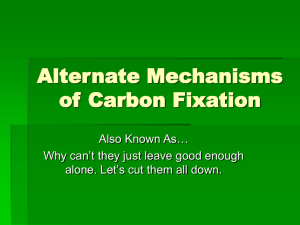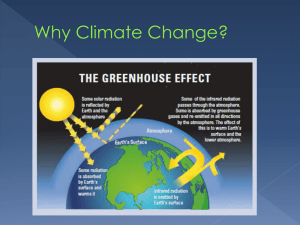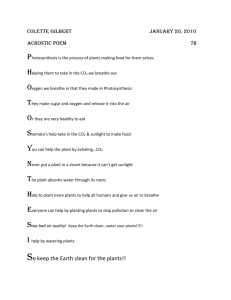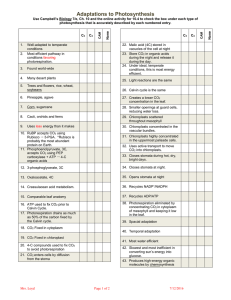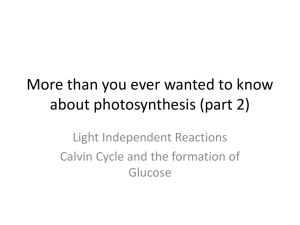Variations in Photosynthesis Lecture 9 Fall 2008
advertisement
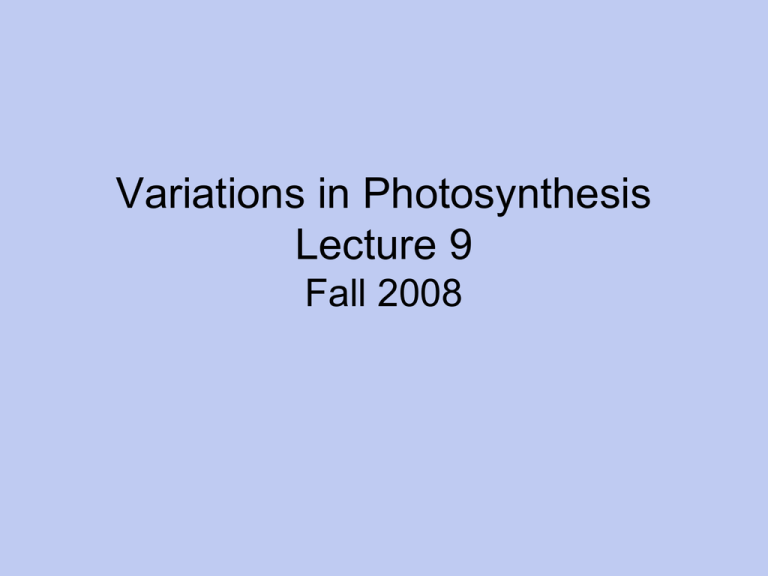
Variations in Photosynthesis Lecture 9 Fall 2008 Variation in Photosynthesis Three types of photosynthesis • C3 • C4 • CAM Why do plants need three different types of photosynthesis? 1 Water Balance in Plants Transpiration – Loss of water vapor from the leaf through diffusion and evaporation • Plants need to balance loss of water to atmosphere with uptake of water from soil 2 Water Loss from Leaves Occurs through stomata (Path) 1. Water vapor in leaf spaces diffuses out of stomata • Leaf air spaces are moist, air is dryer • Driving force: Concentration gradient of water vapor inside vs. outside 2. Liquid water in leaf evaporates to replace water vapor that diffused out Blue dots = water vapor 3 The role of stomata Gas Exchange • CO2 enters, O2 leaves via open stomata Water Balance • Majority of water loss through stomata • Stomata typically open during the day and closed at night • Plant can control whether stomata are open or closed – Can close stomata during the day to prevent water loss 4 Balance between photosynthesis and water loss • Stomata need to be open for gas exchange – No incoming CO2, then low input for Calvin cycle • Stomata need to be closed to prevent excessive water loss – If water in the soil is limited, and – The day is hot or dry 5 Balance between photosynthesis and water loss C3 • Uses a 3-carbon sugar as substrate in Calvin cycle (3-phosphoglycerate) • Stomata open during day, closed at night • Not typically found in dry (arid) environments • In hot temperatures, must close stomata – Photosynthesis reduced, so productivity reduced 6 7 Photorespiration • A metabolic pathway that consumes O2 and ATP, releases CO2 and reduces photosynthetic output – ~50% in some crop plants – Produces no ATP – Produces no sugar – Releases CO2 rather than fixing it Photorespiration 8 • Rubisco (RuBP carboxylase) adds CO2 to ribulose bisphosphate (RuBP) • Rubisco can also bind O2 • O2 and CO2 compete for binding at active site • As concentrations of CO2 decline, O2 gets added to Calvin cycle instead Fig. 10.18 Photorespiration • Results of ribulose bisphosphate & O2 – 3-phosphoglycerate (3 carbon) – Phosphoglycolate (2 carbon) • Phosphoglycolate not used in Calvin cycle • Carbon in phosphoglycolate must be salvaged – Needed for regeneration of RuBP Fig. 10.18 9 10 Photorespiration • Salvage pathway involves chloroplasts, mitochondria and peroxisomes Why Photorespiration? • Rubisco evolved in bacteria before O2 in atmosphere – Enzyme had affinity for both • Modification of active site to reduce access to oxygen may also reduce the access to CO2 • Plants compensate by increasing the concentration of rubisco. – Half of the protein in the chloroplast is rubisco • PR may be protective in terms of preventing damage from excessive light 11 12 Alternative Pathways: C4 C4 • First carbon fixation produces a 4-carbon sugar (oxaloacetate) • Can do photosynthesis with less CO2 coming into leaf • Can close stomata during day, without losing much productivity • Plants found in hot/dry environments – E.g., many grasses, sugar cane, corn Alternative Pathways: C4 • Two types of cells – Mesophyll cells • Carbon fixation (C4 pathway) – Bundle-sheath cells • Calvin cycle in chloroplasts See Fig. 10.19 • Spatial separation • Keeps high CO2 levels in bundle-sheath cells cycle 13 14 Alternative Pathways: C4 In mesophyll cells • C4 Pathway • CO2 fixed to PEP (phosphoenolpyruvate) – Requires PEP carboxylase – Forms oxaloacetate (4 carbon) • PEP carboxylase – No affinity for O2 – Higher affinity for CO2 than rubisco has – Able to add CO2 to PEP even in low CO2 concentrations Fig. 10.19 15 Alternative Pathways: C4 • Oxaloacetate converted to malate or aspartate • Exported from mesophyll cell to bundle sheath cell – Plasmodesmata In bundle-sheath cells • Malate broken down into pyruvate and CO2 • CO2 to Calvin cycle • Pyruvate to mesophyll cells – Regenerates to PEP – Requires ATP Fig. 10.19 17 Cyclic Electron Flow • Uses cyclic electron flow to generate extra ATP • Occurs in bundle-sheath cells – Thylakoids only have PS1 (and cytochrome complex) Fig. 10.15 18 Alternative Pathways: C4 • PS2 primarily in well developed granum • PS1 and ATP synthase primarily in unstacked areas of membrane • Cytochrome complexes distributed evenly Fig. 10.17 19 Alternative Pathways: C4 20 Cyclic Electron Flow • Linear electron flow produces 6 ATP & 6 NADPH – Calvin cycle requires 9 ATP • Cyclic electron flow produces extra ATP – No water split – No O2 produced – No NADPH Fig. 10.15 16 Alternative Pathways: C4 • Besides the 4-carbon product, what else must travel between the mesophyll cells and the bundle sheath cells? 21 Alternative Pathways: CAM CAM (Crassulacean acid metabolism) • Stomata open during night • CO2 stored as 4-carbon compound to be used the next day • Stomata can be closed during the day • Plants found in hot/dry environments – Cactus, pineapple, many orchids – (some are members of plant family Crassulaceae) 22 Alternative Pathways: CAM • Temporal separation of carbon fixation and Calvin cycle • Takes in CO2 at night • Uses C4 pathway to fix CO2 into organic acids – malate • Stored in vacuole – Malic acid – Active transport 23 Alternative Pathways: CAM • Malic acid leaves vacuole • Broken down to form pyruvate and CO2 • CO2 to Calvin cycle • Pyruvate converted to starch and stored 24 Alternative Pathways: CAM Fig. 10.20 24 Trade Offs Why aren’t all plants C4 or CAM? Type of CO2 fixation Energy to fix one CO2 C3 3 ATP Water Transpired per CO2 fixed 400 – 500 g C4 5 ATP 250-300 g CAM 6.5 ATP 50-100 g 26 Importance of Photosynthesis • Provides the carbon compounds for most organisms on the planet • Changed Earth’s atmosphere to the current one • Important part of the CO2 cycle – Moderates temperature on the planet
